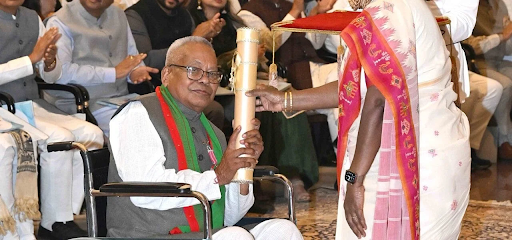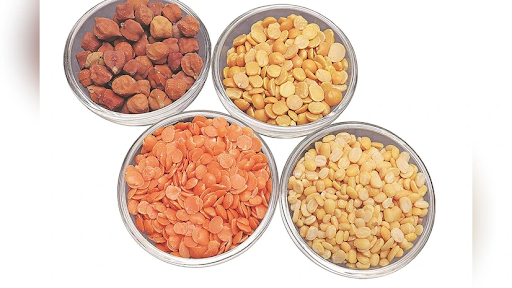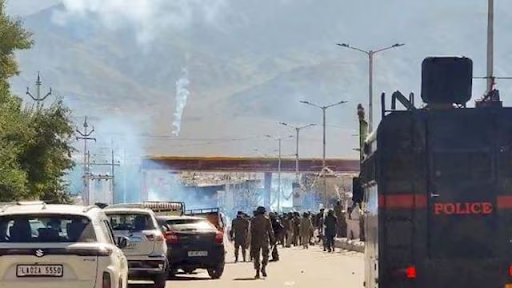Description
Copyright infringement not intended
Picture Courtesy:insamachar.com
Context:
The President of India presents Padma Awards for the year 2025 at Civil Investiture Ceremony-I held at Rashtrapati Bhawan.
About Padma Awards
The government established the Padma Awards in 1954, alongside the Bharat Ratna, India’s highest civilian award. Initially, they have three classes with Hindi names:
- Pahela Varg (First Class)
- Dusra Varg (Second Class)
- Tisra Varg (Third Class)
In 1955, a Presidential Notification renames these classes to give them the names we know today:
- Padma Vibhushan (replacing Pahela Varg)
- Padma Bhushan (replacing Dusra Varg)
- Padma Shri (replacing Tisra Varg)
The awards are announced on the occasion of Republic Day every year. These Awards are conferred by the President at ceremonial functions which are held at Rashtrapati Bhawan usually around March/ April every year.
For the year 2025, the President has approved conferment of 139 Padma Awards; 7 Padma Vibhushan, 19 Padma Bhushan and 113 Padma Shri Awards. 23 of the awardees are women.

Categories of Padma Awards
The Padma Awards come in three categories, each recognizing a different level of contribution:
- Padma Vibhushan: The second-highest civilian award after Bharat Ratna.
- People who deliver exceptional and distinguished service. This means groundbreaking, extraordinary work that impacts the nation significantly.
- Padma Bhushan: The third-highest civilian award.
- Individuals who provide distinguished service of a high order. This is for remarkable work that stands out in a specific field.
- Padma Shri: The fourth-highest civilian award.
- People who show distinguished service in any field. This is for notable contributions, often at a grassroots or community level.
Who Can Get a Padma Award? (Eligibility Criteria)
The Padma Awards are inclusive, meaning almost anyone can qualify, but there are clear rules:
- Who’s eligible:
- Anyone, regardless of race, occupation, position, or gender, can receive the award. This includes Indian citizens, Non-Resident Indians (NRIs), foreign nationals, and Overseas Citizens of India (OCIs).
- Who’s not eligible:
- Government servants, including those working in Public Sector Undertakings (PSUs), cannot get the award.
- Exception: Doctors and scientists in government service can be considered because their work benefits society directly.
- Posthumous awards:
- Normally, the government does not confer awards after someone’s death. However, in highly deserving cases, exceptions happen.
- Time gap for higher awards:
- If someone already has a Padma award (say, Padma Shri) and is nominated for a higher one (like Padma Bhushan), there must be a minimum 5-year gap between the two awards.
- The Awards Committee can relax this rule for exceptional candidates.
- Nominations:
- Anyone can nominate, including the public.
- You can even nominate yourself! This makes the process open and democratic.
Key Facts
- The government limits the total number of Padma awards to 120 per year. This cap excludes posthumous awards and those given to NRIs, foreign nationals, or OCIs, allowing flexibility for exceptional cases.
- The award is an honor, not a title. Awardees cannot use “Padma Shri” or “Padma Vibhushan” as a prefix or suffix to their names.
|
How Are Awardees Selected? (Selection Process)
- Nomination Collection => People submit nominations through the Padma Awards portal or other official channels.
- Padma Awards Committee => The Prime Minister forms this committee every year to evaluate all nominations. The Cabinet Secretary heads it, and it includes senior officials and experts from various fields.
- Recommendations => The committee sends its recommendations to the Prime Minister for review. The Prime Minister forwards the final list to the President of India for approval.
- Award Ceremony => The President presents the awards, usually in March or April, at a grand ceremony in Rashtrapati Bhavan. Awardees receive:
- A Sanad (certificate) signed by the President.
- A medallion with the award’s emblem.
- No cash prize is given, as the honor itself is the reward.
Source:
PIB
|
PRACTICE QUESTION
Q. Which of the following statements about the Padma Awards is/are correct?
- The Padma Awards are announced every year on Republic Day.
- The awards can be given to persons of any race or occupation.
- Awardees receive a Sanad and a medallion signed by the Prime Minister.
- Foreigners can also be conferred Padma Shri.
Select the correct answer using the codes below:
(a) 1 and 2 only
(b) 2 and 4 only
(c) 1, 2 and 4 only
(d) All of the above
Answer: C
Explanation:
Statement 1 is correct: The Padma Awards are announced every year on Republic Day. This is correct.
Statement 2 is correct: The awards can be given to persons of any race or occupation. This is correct. The eligibility criteria state that all persons without distinction of race, occupation, position or sex are eligible.
Statement 3 is incorrect: Awardees receive a Sanad and a medallion signed by the Prime Minister. This is incorrect. The Sanad and medallion are signed by the President of India.
Statement 4 is correct: Foreigners can also be conferred Padma Shri. This is correct. Padma Awards can be conferred on foreigners, NRIs, PIOs, and OCIs.
|











